Contents
Jump to ZingerDx (synth)Jump to FloatCrusher (bit-depth-reducer)
Jump to Sniper (midi-controlled harmonic notch filter)
Jump to PlayDelay (midi-controlled feedback delay)
Jump to PWMDrive (non-symmetric lfo driven tube)
Jump to Firegain (multi band soft clipper)
Jump to Square-o-matic (distorsion)
Jump to Whix (waveshaper)
VST Plugins
On this page you will find free VST plugins created by me (Jonas Norberg) ,and some mp3 audioclips that show them off.The oldest plugin (whix) is from 2000 and the newest (Sniper) is from 2005.
If you find a bug, want to give me ideas for new features of plugins don't hesitate to
mail me at 
LEGAL
VST is a trademark of Steinberg Soft- und Hardware GmbH. I am not in any way affiliated with Steinberg.
All plugins found on this page are freeware. You are free to use and distribute the plugs, but you can not charge anything for it. You use the plug-ins at your own risk. I can not be held responsible for anything bad that might happen.

What is ZingerDx?ZingerDx is a Polyphonic wavetable synt. It is implemented as a VST2.0 plugin.The thing that makes it different from other wavetable synths is that it doesn't feature any waves for its tables. It needs audio to look for waves in. And uses every wave it can find to blend it into the table. (If it does not find anything it actually uses a default wave) Sound qualityAll sound is 32bit floating point internal (all VST plugins are) and I use linear interpolation, but nothing is done to remove aliasing noise (it is not that audible). |
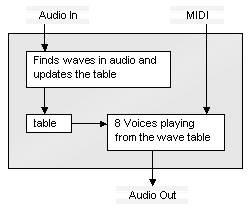
|
Installation
Just copy the ZingerDx.dll to the directory where you other VST plugins are located.If you use Cubase it should be something like:
C:\Programs\Steinberg\Cubase5\VstpluginsYou probably have to restart your VST host.
How to use
You need one audio track (preferably mono) and one midi track to use ZingerDx.- Select ZingerDx as a insert on the audiotrack and turn its power on.
- On the midi channel, choose ZingerDx as output.
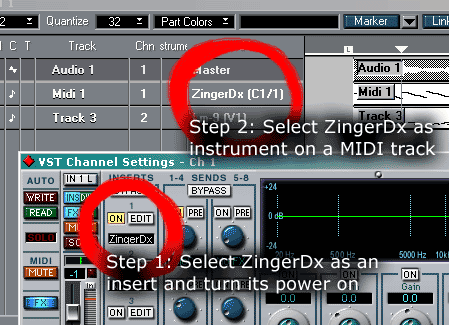
That should be it. Now you should record some wovels and some midi.
You can control two parameters of ZingerDx:
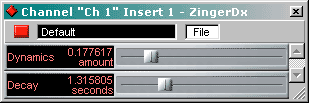
- Dynamics. If this parameter is 1, the amplitude of the input audio is preserved (velocity still also controls the amplitude). If it is 0 only note on velocity controls the amplitude.
- Decay. How many seconds a note will play after a note off. (logarithmic decay)
MIDI
The only MIDI messages ZingerDx cares about is 'Note On' (with velocity), 'Note Off' and 'All Notes Off'Requirements
- Computer running Windows or MacOS.
- VST2.0 compatible host such as CubaseVST or Logic.
(Only tested on Cubase VST 5 for PC)
Download
ZingerDx.dllThe plugin for Win. Just save to VstPlugins directory. (110k)
ZingerDx.zip
The plugin for Win zipped. (47k)
ZingerDx.sit
The plugin for MacOS (stuffit archive). (21k)
ZingerDxTest.mp3
A audioclip in mp3 format (282k)
(The only thing that's added are the drums, and some reverb)
It might be a good idea to download this text as well. ("File-Save as" in IE)

The samples in all vst hosts are represented by 32-bit floats, this enables huge dynamic overhead compared to integers.
Other bitcrusher converts the float to an integer and the bit reduction is a product of that conversion. The quality depends on how many bits the integer can hold. This is mostly done to mimic early (or cheap) digital equipment (samplers, home-computers and videogames)
FloatCrusher does not try to mimic the limitations of old hardware, it is designed to lower the resolution of floats in the most natural way, by just setting the lowest bits to zero. You can control how many bits you wish to clear with a slider.
To learn about floats visit: http://www.h-schmidt.net/FloatApplet/IEEE754.html
Download
FloatCrusher.dllThe plugin for Win. Just save to VstPlugins directory. (108k)
FloatCrusher.mp3
A audioclip in mp3 format
the clip contains one before-after pair.
Sniper
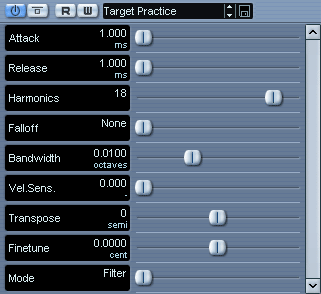
User Interface
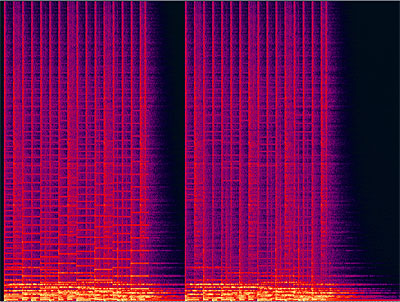
Spectral view of before after pair
This plug contains 64 narrow notch filters controlled by midi. By default no filters are active. When a note-on is received a group of notch filters corresponding to the harmonic content of the note is started.
In special circumstances this plug allows you to remove or attenuate specific instruments from a mix while leaving the other virtually untouched.
Download
Sniper.rarThe plugin for Win and a manual. Just unpack to VstPlugins directory. (53k)
Sniper.mp3
A audioclip in mp3 format
the clip contains one before-after pair. A Sniper is used to remove only the melody.
PlayDelay
Download
PlayDelay.dllThe plugin for Win. Just save to VstPlugins directory. (77k)
PlayDelay.mp3
A audioclip in mp3 format
the clip contains one before-after pairs.

I called it PWMDrive since, when maxed out, it can produce
sounds similar to a pulse-width-modulated square wave.
The waveshaping function is out = in/(1+in)). Actually its like that on positive x, and symmetrical around zero) I'm not sure if this is similar to a "real" tube, but it sounds great, if you have any suggestions on different shape-functions, that have similar (or less) cost, please let me know.
An sweet-sounding oversampling option is provided, mainly meant to be used at mixdown-time, since it's rather expensive.
The steps performed are:
- Measure the amplitude
- DC-Offset signal depending on amplitude (lfo-controlled)
- Gain
- SoftClip
- HiPass (to remove dc)
- Gain
Download
pwmdrive.dllThe plugin for Win. Just save to VstPlugins directory. (20k)
pwmdrive.mp3
A audioclip in mp3 format
the clip contains two before-after pairs.

- Divide the signal into three frequency bands using box-filters.
- Applies soft clipping to each of the bands.
- Recombine the signals to create a final signal.
Download
firegain.dllThe plugin for Win. Just save to VstPlugins directory. (77k)
firegain.mp3
A audioclip in mp3 format
the clip contains two before-after pairs.

- Envelope-Follower
- Square-maker
- Lowpass filter with resonance (cutoff is controlled by the env-follower)
There are four parameters:
- Falloff this controls the env-follower.
- Cutoff follow this multiplies the range of the env-follower, you should adjust this depending on the amplitude of the signal.
- Lowest cutoff this offsets the range of the env-follower.
- Resonance
Square-o-matic will try to create square waves from other waves. It works best on sond that are symmetrical. That is, the upper halve (above zero) of the wave is similar to the lower halve (below zero).
The envelope follower detects the current amplitude, the attack is instantanious and the release is controlled by the Falloff knob.
The Cutoff of the filter is calculated like this:
CO = (current amplitude) * ("Cutoff follow"-knob) + ("Lowest cutoff"-knob)
CO is then clamped to [0..1]
This means that if the Lowest cutoff is "1" the filter will always be open. If the material is quiet, the "Cutoff follow"-knob can be raised to enable the filter to open.
Square-o-matic produces aliasing noise. So handle width care.
Thanks alot to Sophia Poirier of destroyFX fame for bringing square-o-matic to the mac.
Download
Square-o-matic.dllThe plugin for Win. Just save to VstPlugins directory. (106k)
Square-o-matic-mac.sit
The plugin for Classic Mac. (20k)
Square-o-matic-carbon.sit
The plugin for MacOS X. (20k)
Square-o-matic-test.mp3
A audioclip in mp3 format
the clip contains three before-after pairs

- Lowpass filter
- Gain
- Wave shaper (sine function)
- Lowpass filter
- Gain
The windows version has some extra functionality, an envelope follower that adjust the output volume to match the input volume. (If the input is quiet, it does not output noise)
In my humble opinion Whix works best on simple sounds (think triangle, saw) and tends to be pretty noisy with complex sounds (voice and chords)
Whix produces aliasing noise. So handle width care.
Download
whix.sitMac version 1.2 (20k .sit) Added the last gain-control.
whix.zip
Windows version (46k .zip) Added Envelope follower.
whix.mp3 the clip contains three before-after pairs
